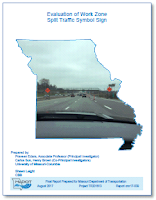Flagger safety is an important issue in work zones due to the proximity of the flagger to traffic. Some strategies for improving flagger safety include slowing down approaching vehicles or removing flaggers from the immediate vicinity of traffic. The Automated Flagger Assistance Device (AFAD) is a system that can potentially accomplish both of the aforementioned strategies. In order to validate the effectiveness of AFADs in highway work zones, field testing was performed using an AFAD with a Changeable Message Sign (CMS) on a 2-lane work zone in Missouri. The field study found that AFADs helped to lower approach speeds and encouraged vehicles to stop farther behind the AFAD than a traditional flagger. In addition, a driver intercept survey found that the AFAD was viewed favorably by the general public. These field results found that AFADs are more effective than human flaggers, and drivers prefer AFADs over human flaggers.
VIEW FULL REPORT
Report number: cmr17-010
Published: August 2017
Project number: TR201717
Author(s): Henry Brown, Carlos Sun, Siyang Zhang and Zhu Qing
Performing organization: University of Missouri-Columbia
Friday, August 4, 2017
Thursday, August 3, 2017
Evaluation of Work Zone Split Traffic Symbol Sign
VIEW FULL REPORT
Report number: cmr17-009
Published: August 2017
Project number: TR201613
Author(s): Praveen Edara (PI), Carlos Sun (co-PI), Henry Brown (co-PI), University of Missouri-Columbia and Shawn Leight, CBB
Performing organization: University of Missouri-Columbia
Subscribe to:
Posts (Atom)

